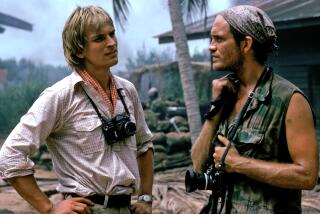It Takes One to Film One
- Share via
Boy meets girl. Boy loses girl. Boy dies.
That’s the narrative outline of “Basquiat,” the new movie based on the life of a graffiti tagger who became an internationally acclaimed painter by the age of 21 but who succumbed to an overdose of opiates and cocaine six chronologically brief, emotionally endless years later. Faster than you can say “war on drugs,” Jean-Michel Basquiat went from being Samo (a graffiti tag short for Same Old [Expletive]) to representing a moralistic cautionary tale about 1980s art world excess.
The outline shows how “Basquiat” targets Hollywood’s codified solar plexus, then veers off into a land of quirky twist. Strength or weakness, take your pick; this picture is worth seeing for a different reason entirely.
Simply: It’s the only movie I’ve ever seen that inescapably feels like it’s about an actual artist, not about a goofball fantasy of an artist, which is what usually gets unspooled.
This is no small achievement. Whatever your response to the operatic screenplay, you never once feel the need to willfully (or wincingly) suspend disbelief when this artist is at work.
Maybe it takes one to know one. Basquiat the movie was written and directed by painter Julian Schnabel, another meteor from the decade past.
To the great surprise of no one, the movie presents a romance of art whose epic aesthetic of kitschy elegance comes straight from Schnabel’s own paintings. (What else could it do?) Known for an outsize ego, the writer-director-artist even usurps the story: Schnabel’s pseudonymous stand-in, painter Albert Milo (Gary Oldman), counsels Basquiat from the princely perch of an older and wiser aerialist who’s managed not to fall from the treacherous art world high wire.
One amusing scene shows diva Andy Warhol (David Bowie) and nouveau superstar Basquiat (Jeffrey Wright) in Warhol’s studio working on one of the god-awful collaborative paintings they made in the mid-’80s and philosophizing about the cruel isolation that accompanies success. Big silk-screen paintings placed prominently in the background display talismanic portraits of a solitary Schnabel, like some Roman deity in a Baroque ceiling decoration eavesdropping on hapless mortals.
From the perspective of 1996 you perceive: Warhol, dead; Basquiat, dead; Schnabel, alive and well and making movies.
This is not a documentary. Schnabel’s script does take liberties.
Some are small. Warhol was having lunch with curator Henry Geldzahler (Paul Bartel), not art dealer Bruno Bischofberger (Dennis Hopper), when the still-unknown Basquiat showed up scruffy and unannounced at their posh table and tried to sell them his drawings at 10 bucks a pop.
Others are large. Gina Cardinale (Claire Forlani)--the girl in the boy-meets-girl scenario--is a composite character.
So historians and movie critics might have their complaints. But never mind. “Basquiat” is uniquely convincing in its portrayal of an artist.
Why? Because Schnabel doesn’t load him down with the requirement of personifying an idea. The artist doesn’t symbolize anything--like Modern Alienation or Holy Fool. He’s not a type, he’s a person--specific to a time and place. Wright’s lovely performance gives us a Basquiat who is stylish, smart, obnoxious, charismatic, foolish, cowardly, sexy, selfish, funny, scared. And oh, by the way, he has an artist’s gift.
Schnabel even makes fun of artist-personality mongering, especially in a scene where an unctuous television interviewer (Christopher Walken) keeps asking how and why Basquiat is so good but gets nowhere. Basquiat’s status as an artist is shown as essentially matter-of-fact. Which is--at long last--just as it should be.
More to Read
Only good movies
Get the Indie Focus newsletter, Mark Olsen's weekly guide to the world of cinema.
You may occasionally receive promotional content from the Los Angeles Times.







